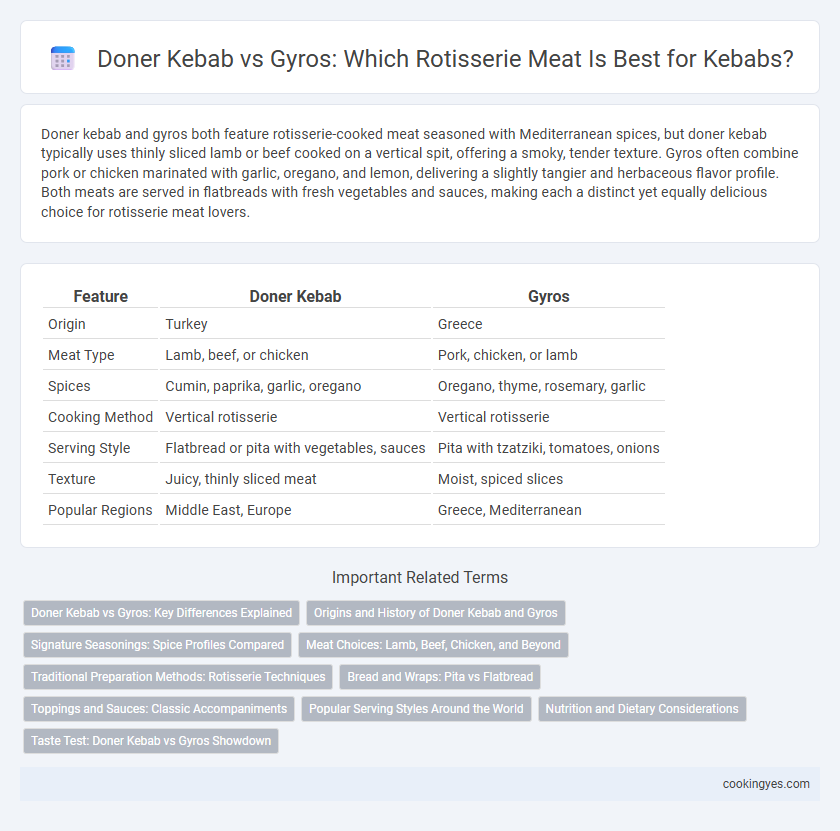Doner kebab and gyros both feature rotisserie-cooked meat seasoned with Mediterranean spices, but doner kebab typically uses thinly sliced lamb or beef cooked on a vertical spit, offering a smoky, tender texture. Gyros often combine pork or chicken marinated with garlic, oregano, and lemon, delivering a slightly tangier and herbaceous flavor profile. Both meats are served in flatbreads with fresh vegetables and sauces, making each a distinct yet equally delicious choice for rotisserie meat lovers.
Table of Comparison
| Feature | Doner Kebab | Gyros |
|---|---|---|
| Origin | Turkey | Greece |
| Meat Type | Lamb, beef, or chicken | Pork, chicken, or lamb |
| Spices | Cumin, paprika, garlic, oregano | Oregano, thyme, rosemary, garlic |
| Cooking Method | Vertical rotisserie | Vertical rotisserie |
| Serving Style | Flatbread or pita with vegetables, sauces | Pita with tzatziki, tomatoes, onions |
| Texture | Juicy, thinly sliced meat | Moist, spiced slices |
| Popular Regions | Middle East, Europe | Greece, Mediterranean |
Doner Kebab vs Gyros: Key Differences Explained
Doner Kebab and Gyros both feature rotisserie-cooked meat but differ primarily in seasoning and origin; Doner Kebab hails from Turkey and utilizes a spiced lamb or beef blend marinated with cumin, paprika, and garlic, while Gyros originates from Greece and incorporates pork or chicken seasoned with oregano, thyme, and rosemary. The cooking techniques are similar, involving vertical rotisserie grilling that ensures juicy, thinly sliced meat, yet the flavor profiles reflect their distinct culinary traditions. Serving styles also vary: Doner Kebab is often wrapped in flatbread with fresh vegetables and yogurt-based sauces, whereas Gyros typically includes pita bread, tomatoes, onions, and tzatziki sauce.
Origins and History of Doner Kebab and Gyros
Doner Kebab, originating in 19th-century Ottoman Turkey, is a seasoned meat cooked on a vertical rotisserie, traditionally made from lamb or beef, and has become a staple in Middle Eastern and European cuisines. Gyros, developed in Greece during the 1920s, is a similar preparation that uses pork or chicken, influenced by the Turkish doner but adapted to Greek flavors and culinary traditions. Both dishes reflect cultural exchanges around the Mediterranean, with doner kebab emphasizing spiced meat layers and gyros featuring marinated, sliced meat served with pita and tzatziki.
Signature Seasonings: Spice Profiles Compared
Doner Kebab showcases a complex spice profile blending cumin, coriander, and paprika, delivering a smoky, earthy flavor enriched by garlic and onion. Gyros features a Mediterranean seasoning mix mainly composed of oregano, thyme, and rosemary, offering a fresh, herby aroma with hints of lemon and garlic. Both rely on distinctive spice combinations that highlight regional culinary traditions while enhancing the savory rotisserie meat experience.
Meat Choices: Lamb, Beef, Chicken, and Beyond
Doner kebab traditionally features seasoned lamb or beef, slow-cooked on a vertical rotisserie to achieve tender, flavorful meat, while gyros frequently utilize pork or chicken, marinated with Mediterranean herbs and spices. Beyond classic protein choices, variations now include turkey and plant-based options, catering to diverse dietary preferences. Both preparations emphasize juicy, thinly sliced meat but differ in seasoning profiles and regional meat selections.
Traditional Preparation Methods: Rotisserie Techniques
Doner Kebab and Gyros both rely on vertical rotisserie techniques where seasoned meat is stacked in a cone shape and slow-cooked by radiant heat. Doner Kebab traditionally uses lamb, beef, or chicken marinated with Middle Eastern spices, while Gyros feature pork or chicken seasoned with Mediterranean herbs like oregano and thyme. The slow rotation ensures even cooking, producing tender, juicy slices essential to each dish's authentic flavor profile.
Bread and Wraps: Pita vs Flatbread
Doner kebab typically features thinly sliced rotisserie meat wrapped in soft, fluffy flatbread that absorbs flavorful sauces and preserves juiciness. Gyros use thicker, pocket-style pita bread that holds meat, tzatziki, and toppings securely, offering a sturdy wrap ideal for handheld eating. The choice between pita and flatbread significantly influences texture and presentation, enhancing the overall experience of these iconic rotisserie meat dishes.
Toppings and Sauces: Classic Accompaniments
Doner Kebab traditionally features toppings like shredded lettuce, tomatoes, onions, and tangy pickled red cabbage, paired with sauces such as garlic yogurt, spicy red pepper, or creamy tahini. Gyros typically include fresh tomatoes, onions, and tzatziki sauce made from yogurt, cucumber, garlic, and dill, enhancing the rotisserie meat's Mediterranean flavor profile. Both offer unique, classic accompaniments that highlight regional tastes and complement their distinctive seasoning styles.
Popular Serving Styles Around the World
Doner kebab and gyros both feature rotisserie-cooked meat but differ in their popular serving styles globally. Doner kebab is commonly served in pita bread or flatbreads with fresh vegetables and a variety of sauces, especially in Middle Eastern and European countries. Gyros, originating from Greece, typically come wrapped in a pita with tzatziki sauce, onions, tomatoes, and sometimes fries, highlighting Mediterranean flavors and serving preferences.
Nutrition and Dietary Considerations
Doner kebab and gyros both feature rotisserie-cooked meat, typically lamb, beef, or chicken, but their nutritional profiles vary due to seasoning and preparation methods. Doner kebab often contains higher sodium levels and may include added fats for juiciness, while gyros tend to use leaner cuts and Mediterranean spices, contributing to lower saturated fat content and antioxidant benefits. For dietary considerations, gyros can be better for heart health and weight management, whereas doner kebab may offer higher calorie content suitable for active individuals seeking energy-dense meals.
Taste Test: Doner Kebab vs Gyros Showdown
Doner Kebab and Gyros both feature rotisserie-cooked meat but differ distinctly in flavor profiles and seasoning, with Doner Kebab offering a spicy, herb-infused taste accented by cumin and paprika, while Gyros emphasizes a savory blend of oregano, garlic, and lemon zest. Taste tests consistently highlight Doner Kebab's juicy, slightly smoky texture contrasted against Gyros' tender, tangy notes, making each uniquely satisfying depending on preference for bold versus aromatic flavors. The cooking style remains similar, but regional spice blends and marination techniques drive the taste showdown between these two Mediterranean classics.
Doner Kebab vs Gyros for Rotisserie Meat Infographic

 cookingyes.com
cookingyes.com